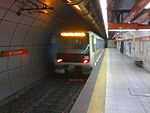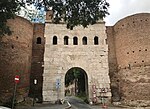Sant'Antonio di Padova a Circonvallazione Appia
20th-century Roman Catholic church buildings in ItalyRome Q. IX Appio-LatinoTitular churches

Sant'Antonio di Padova a Circonvallazione Appia (Saint Anthony of Padua at the Appian Ring-Road) is a church in Rome, built in 1938 in the Rationalist style. It was made a cardinalate deaconry on 18 February 2012 by Pope Benedict XVI. The recent assigned cardinal was Karl-Josef Rauber.
Excerpt from the Wikipedia article Sant'Antonio di Padova a Circonvallazione Appia (License: CC BY-SA 3.0, Authors, Images).Sant'Antonio di Padova a Circonvallazione Appia
Circonvallazione Appia, Rome Municipio Roma VII
Geographical coordinates (GPS) Address External links Nearby Places Show on map
Geographical coordinates (GPS)
| Latitude | Longitude |
|---|---|
| N 41.875180555556 ° | E 12.512919444444 ° |
Address
Circonvallazione Appia
00183 Rome, Municipio Roma VII
Lazio, Italy
Open on Google Maps









